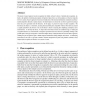124 search results - page 2 / 25 » Simplifying Sets of Events by Selecting Temporal Relations |
ESANN
2008
13 years 6 months ago
2008
Sequential Minimal Optimization (SMO) is currently the most popular algorithm to solve large quadratic programs for Support Vector Machine (SVM) training. For many variants of this...
LOGCOM
2002
13 years 4 months ago
2002
We present a logical approach to plan recognition that builds on Kautz's theory of keyhole plan recognition, defined as the problem of inferring descriptions of high-level pl...
COLING
2010
12 years 11 months ago
2010
We describe a Chinese temporal annotation experiment that produced a sizable data set for the TempEval-2 evaluation campaign. We show that while we have achieved high inter-annota...
RAID
1999
Springer
13 years 9 months ago
1999
Springer
Lately, many approaches have been developed to discover computer abuse. Some of them use data mining techniques to discover anomalous behavior in audit trail, considering this beh...
ACL
2004
13 years 6 months ago
2004
Temporal relation resolution involves extraction of temporal information explicitly or implicitly embedded in a language. This information is often inferred from a variety of inte...

